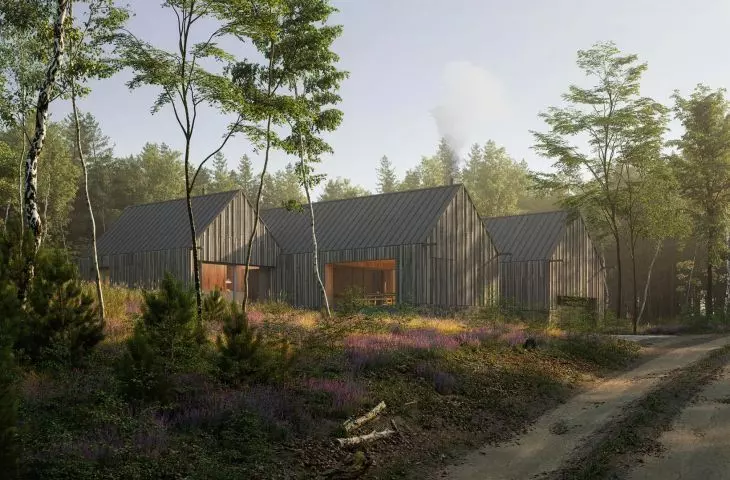In Kashubia, in the heart of the Wdzydze Landscape Park, a team from the INTERURBAN studio in Gdynia designed the Forest House - a modern, yet integrated into the natural surroundings, single-family house inspired by traditional architecture and the layout of local homesteads. How successful was this marriage?
The architects adapted the classic homestead layout, in which individual buildings on each side enclosed the plot, to the modern needs of the householders - they combined four blocks in a rhythmic, alternating arrangement, thus creating a coherent, amphitheatre sequence, and at the same time separated the main functions of the building.
block shaping scheme
© INTERURBAN
Each part is formed by a simple rectangular-plan object covered by a gabled roof. The archetypical bodies of the houses, although "dressed" in traditional materials - stone foundation and facades made of local wood - are thoroughly modern - minimalist, with large windows, covered with a dark roof without eaves.



front elevation of the house
image: SZUMgroup © INTERURBAN
Lukasz Piankowski, the author of the concept, talks about the design process, the environment that determines the architecture and the final shape of the block.
Ola Kloc: The house will be located in the Wdzydze Landscape Park, how did the forest surroundings influence the design?
Lukasz Piankowski: Basically, the building will stand in the place where originally there was a small forester's lodge - an object whose function was dominated by the ongoing maintenance of the forest, characterized by simplicity and functionality. This is also how we approached the design of this house - the logical layout of the space in conjunction with the needs of the residents is a reference to historical homestead layouts but in a new edition. Surrounded by a forest, we decided to use wood as the main façade material, otherwise just obtained from the local forest district - the investor had already started to store the material before the decision to build.
The 


The inspiration for the architecture was the surrounding nature of the plot
vision: SZUMgrupa © INTERURBAN
Ola: What was the investor's priority?
Lukasz: First and foremost, a comfortable spacious house responding to the modern needs of the residents. The idea was to make the building inseparable from the place where it is located. Nowadays we notice a big tendency to "package" architecture in various easily available solutions, not necessarily derived from local building traditions or simply good quality. The result of such actions is chaos. Together we wanted this house to result directly from the place it is located.
axonometry and plan of the house
© INTERURBAN
Ola: The house consists of four alternating solids of different sizes, what is the reason for such a layout and what does it mean for the residents?
Lukasz: It is a transformation of a typical homestead layout into a new one, adapted to the needs of modern man. In the past, there was a division between residential, farm and livestock buildings - now there is no need to separate animals from people, etc. because no one is engaged in such activities. Hence the amphitheater layout of barns referring to the old functional divisions with the difference that now we separate the functions of typical residential (day and night) from economic or technical.
The 


The inspiration for the architecture was the nature surrounding the plot of land
vision: SZUMgroup © INTERURBAN
Ola: What was the most difficult part of this project, and what are you most satisfied with?
Lukasz: The most difficult thing turned out to be obtaining permits, this is a process that still takes a lot of time in our country, even more so if we are dealing with something different in the minds of local officials. We assume that an architect not only draws, but also builds, so after implementation we will be able to assess what we are most satisfied with.
Ola: Thank you for the interview.












































